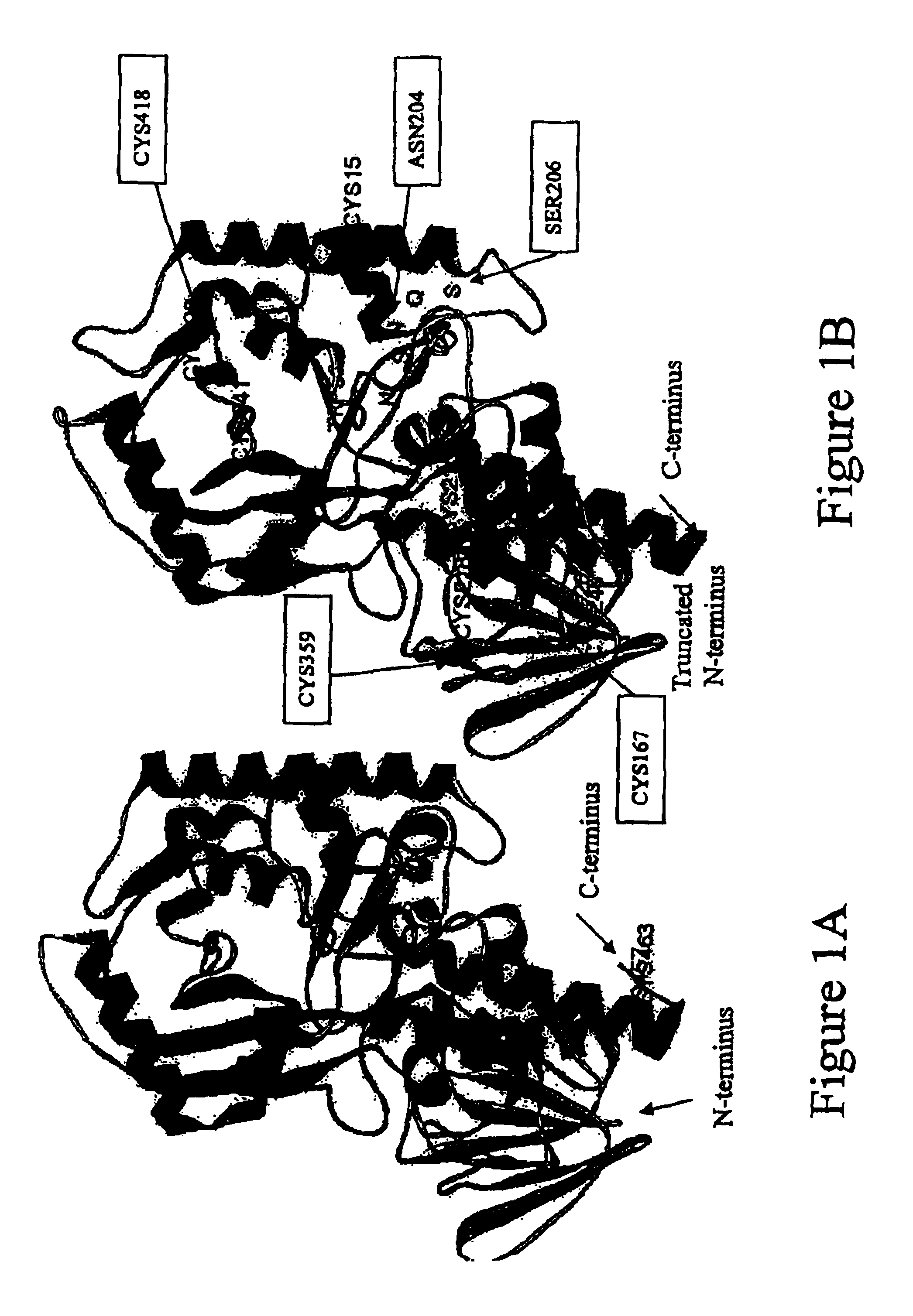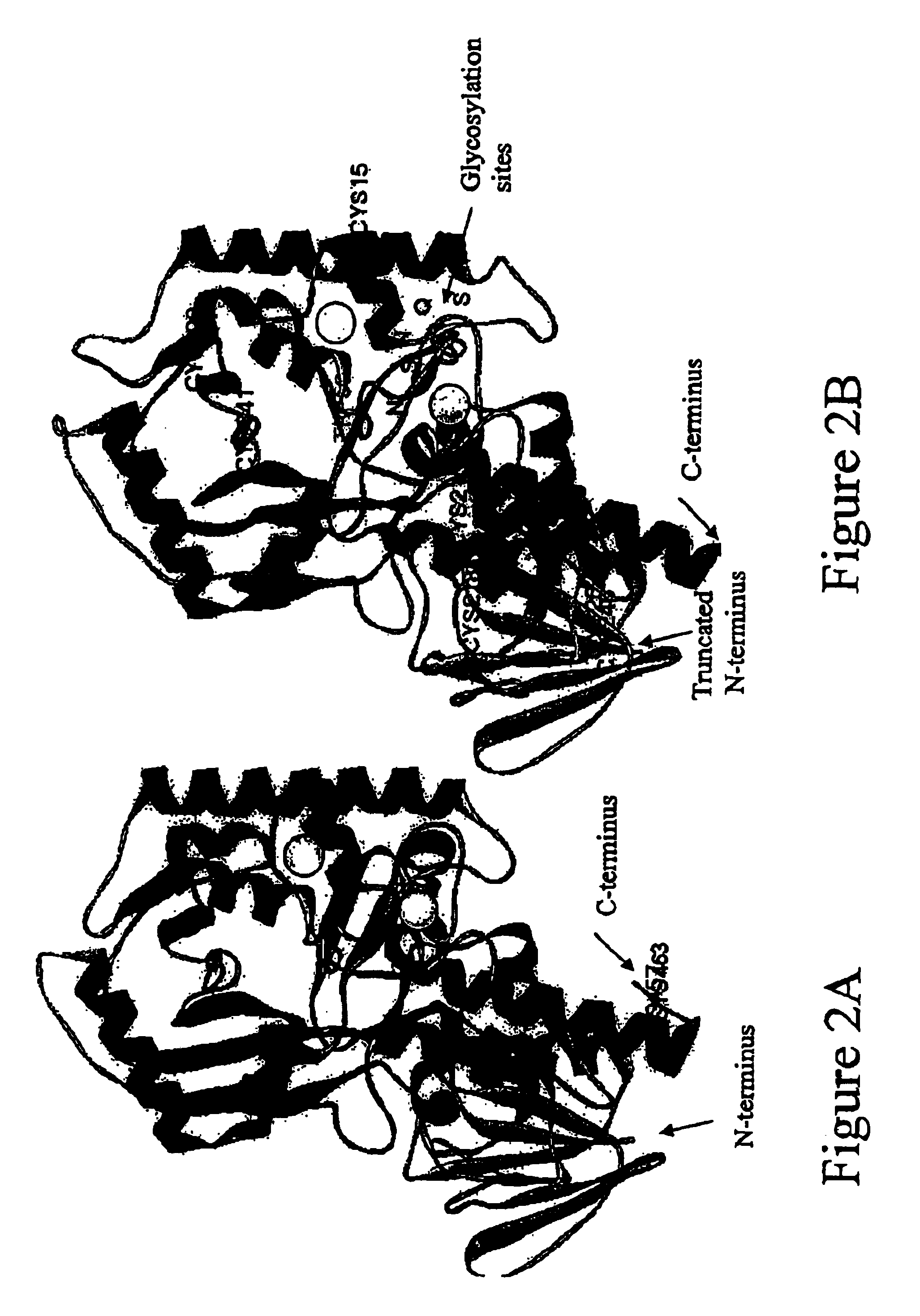Amino polyol amine oxidase polynucleotides and related polypeptides and methods of use
a technology of amino polyol amine oxidase and polynucleotides, which is applied in the field of detection and isolation of fumonisin and ap1 degrading enzymes, can solve the problems of difficult plant cultivation and common problems of fungal diseases
- Summary
- Abstract
- Description
- Claims
- Application Information
AI Technical Summary
Benefits of technology
Problems solved by technology
Method used
Image
Examples
example 1
[0152]Fungal and bacterial isolates. Exophiala isolates from maize were isolated as described in U.S. Pat. No. 5,716,820, issued Feb. 10, 1998; U.S. Pat. No. 6,025,188, issued Feb. 15, 2000; and U.S. application Ser. No. 08 / 888,950, filed Jul. 7, 1997, and herein incorporated by reference.
[0153]Isolation methods. Direct isolation of black yeasts from seed was accomplished by plating 100 microliters of seed wash fluid onto YPD or Sabouraud agar augmented with cycloheximide (500 mg / liter) and chloramphenicol (50 mg / liter). Plates were incubated at room temperature for 7-14 days, and individual pigmented colonies that arose were counted and cultured for analysis of fumonisin-degrading ability as described in U.S. Pat. No. 5,716,820, issued Feb. 10, 1998; U.S. Pat. No. 6,025,188, issued Feb. 15, 2000; and U.S. application Ser. No. 08 / 888,950, filed Jul. 7, 1997.
[0154]Analysis of fumonisins and metabolism products. Analytical thin-layer chromatography was carried out on 100% silanized C1...
example 2
Preparation of AP1-induced and Non-induced Mycelium
[0161]Liquid cultures of Exophiala spinifera isolate 2141.10 were prepared from YPD agar plates (Yeast Extract 10 gm, Bacto-Peptone 20 gm, Dextrose 0.5 gm, and Bacto-Agar 15 gm per liter of water). Aliquots (400-500 uL) of a water suspension of E. spinifera cells from YPD agar were spread uniformly onto 150×15 mm YPD agar plates with 4 mm sterile glass beads. The plates were incubated at room temperature for 6-7 days. The mycelia / conidia were transferred from the agar plates into Mineral Salts Medium (MSM) (Na2HPO4.7H2O 0.2 gm, NH4Cl 1.0 gm, CaCl2.2H2O 0.01 gm, FeSO4.7H2O 0.02 gm per liter of distilled water, pH 4.5) and centrifuged at 5000×g, 4° C., 20 minutes to pellet the cells. The cell pellet was rinsed once in 40 ml MSM and recentrifuged. The rinsed cell pellet was used to inoculate MSM at a 1:19 ratio of packed cells: MSM. The culture to be induced was supplemented with AP1 to a final concentration of 0.5-1.0 mg / ml and incuba...
example 3
Effect of FB1 and AP1 on Maize Coleoptiles
[0162]Maize coleoptiles from 4 day dark-grown germinated maize seeds were excised above the growing point and placed in 96-well microtiter plates in the presence of 60 microliters of sterile distilled water containing FB1 or AP1 at approximately equimolar concentrations of 1.5, 0.5, 0.15, 0.05, 0.015, 0.005, 0.0015, or 0.0005 millimolar, along with water controls. After 2 days in the dark at 28° C. the coleoptiles were placed in the light and incubated another 3 days. Injury or lack thereof was evaluated as follows:
[0163]
0.0005.0015.005.015.05.15.51.5mMFB1−−−−+ / −++++AP1−−−−−−−−++ = brown necrotic discoloration of coleoptile − = no symptoms (same as water control)
[0164]The results (see table above) indicate there is at least a 30-fold difference in toxicity between FB1 and AP1 to maize coleoptiles of this genotype. This is in general agreement with other studies where the toxicity of the two compounds was compared for plant tissues: In Lemna...
PUM
| Property | Measurement | Unit |
|---|---|---|
| Fraction | aaaaa | aaaaa |
| Fraction | aaaaa | aaaaa |
| Fraction | aaaaa | aaaaa |
Abstract
Description
Claims
Application Information
 Login to view more
Login to view more - R&D Engineer
- R&D Manager
- IP Professional
- Industry Leading Data Capabilities
- Powerful AI technology
- Patent DNA Extraction
Browse by: Latest US Patents, China's latest patents, Technical Efficacy Thesaurus, Application Domain, Technology Topic.
© 2024 PatSnap. All rights reserved.Legal|Privacy policy|Modern Slavery Act Transparency Statement|Sitemap



